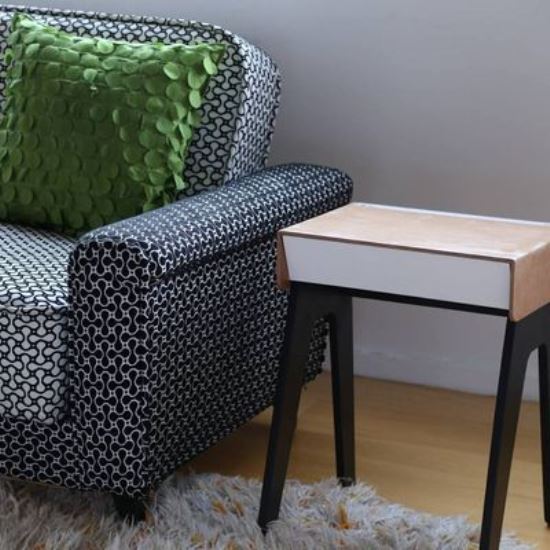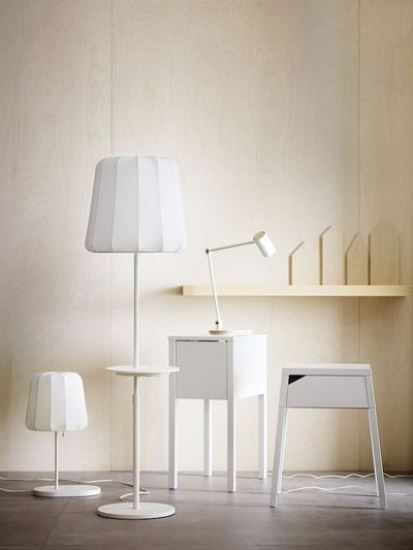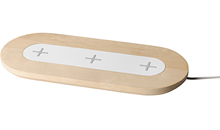What's the deal with wireless charging furniture?
Source:curbed.com
Wireless device charging is already being rolled out in the next generation of technologically tricked out furniture, with more and more phones and tablets featuring compatible charging technology.

Startup Curvilux's $250 wireless charging side table is currently available to be preordered.
As any design-obsessed human can tell you, nothing ruins the look of a modern, minimalist room quite like a power cable haphazardly snaking its way from socket to tabletop. Until recently, unsightly cords were a necessary evil of the digital age. But all that’s about to change.
Wireless device charging is already being rolled out in the next generation of technologically tricked out furniture, with more and more phones and tablets featuring compatible charging technology. Last year, Swedish furniture giant Ikea planted a flag in the realm of wireless-charging furniture with the launch of a collection embedded with the technology, but now dozens of smaller players are joining the fight with designs of their own.
We talked with Grant Reig, Product Manager at the MIT-born wireless energy company WiTricity, to find out everything you need to know about this brave new world of cord-free, device-charging goods.
How does wireless charging work?
Wireless charging works by transmitting energy through an electromagnetic field. "If you have a Sonicare toothbrush, it’s powered by basic induction," Reig explains. The process requires two devices—a base and a receiver—each containing a loop of wire known as an induction coil. Running electrical current through the wire in the base creates a magnetic field. When you place the receiver’s coil in that field, the opposite happens: Energy is converted back into electricity without the base and receiver needing to physically touch.
One promising variation on this process happens to be WiTricity’s specialty. Known as magnetic resonance, this technique makes the energy transfer more efficient by vibrating the magnetic field created by the base at the same frequency as the receiver. This enables the base to transmit energy to the receiver at a stronger rate, even when they’re farther apart.
How long has this technology existed?
"You can go all the way back to Nicola Tesla and his version of wireless power and inductive technology," says Reig. More than a century ago, the prolific inventor was already making wirelessly powered devices. But it’s only until relatively recently that this technology has become small and efficient enough to be integrated into consumer products.
Reig believes that wireless power hasn’t yet gone mainstream because poor user experiences are holding it back from widespread use. But every technological advancement in the field brings us closer to a world of wirelessly accessible power. And again, it’s just a matter of time.
Does wireless charging work well?
With our current inductive technology, a phone or tablet can’t be wirelessly charged at the same high speeds as with a wired charger. But engineers are working on closing this gap, and it’s likely just a matter of time, says Reig.
Placement of the base and receiver are another consideration. "With traditional induction, it’s important that the two wires are relatively similar in size and in close proximity," Reig says. The base and the receiver have to be placed within a millimeter or two of each other. This is why most of the existing pieces of wirelessly charging furniture include clear visual indicators for precisely where to place your device.
But resonant technology has the potential to provide a charge over larger distances of six feet or more, which means you’ll soon be able to scroll through Twitter even as your phone is charging, without being tethered to the wall.

Ikea's wireless charging furniture collection includes lamps, tables, and charging pads. Photo courtesy Ikea
Who is making wireless charging furniture?
As Curbed recently discussed, a number of companies are venturing into the field of wireless charging furniture. Ikea is the largest player, with a collection of lamps and side tables embedded with the technology in addition to offering stand-alone charging pads.
As Ikea product developer Bjorn Block—who worked on the company’s wireless collection—told Curbed, "charging mobile devices was a pain point in life at home. People couldn’t find their charger, the cable was too short, and all the chargers and cables create a mess at home." Adding, "Hide-tech is the ultimate hi-tech."
But Ikea isn’t alone. Argentina-based company Curvilux successfully launched a crowdfunding campaign earlier this year for a nightstand featuring a wireless charging pad. And the London-based company Fonesalesman is also working on a line of wirelessly charging furniture—dubbed FurniQi—starting with a bamboo nightstand integrated with a charging pad.
Is wireless charging limited to new furniture?
"I’ve even taken antique tables at my house and retrofitted them with wireless charging," says WiTricity’s Grant Reig. The company—which licenses its technology to other companies rather than creating its own products—has demoed charging pads that can be hidden on the underside of existing furniture pieces, meaning that you’ll be able to take advantage of this technology without throwing out your grandmother’s Victorian dining set or the original Eames desk you’ve always coveted.
"Antiques made of wood are actually quite good for that," says Reig, "especially with magnetic resonance where you can separate the base and the receiver."

The FurniQi side table from Fonesalesman $199. Photo courtesy Fonesaleman
What can wireless charging furniture be made of?
The magnetic field generated by the base can safely pass through most materials including wood, glass, ceramics, and even the human body, says Reig. "But aluminum, steel, and other metal materials will block that field." A metal screw or two won’t affect the power transfer, but a tabletop made of a sheet of metal or even having large metal supports can keep the technology from working properly.
How much does wireless charging furniture cost?
The most expensive aspect of wireless charging furniture is—surprisingly—the furniture. The technology itself is relatively affordable, with stand-alone bases and receivers costing anywhere from $10 to $60. Ikea’s wireless charging line has items ranging from $30 to $180, but that doesn’t include a receiver-embedded phone case. The Curvilux nightstand costs about $250, and a FurniQi side table is $199.
Crafty types can also make their own wireless charging furniture for as little as $10 by embedding an inductive charger into an existing piece.
How will the technology change and improve?
All of the current lines of wirelessly charging furniture still have to get electricity directly from a wall outlet. That means your new nightstand or table lamp will be wired. But new developments in the technology could lead to furniture pieces and devices powered through the carpet or across greater distances so that your phone can be receiving a constant charge no matter where you are.
"We’re looking forward to wireless power being a lot more ubiquitous, embedded in everything you touch," says Reig. "Everywhere from the center console of a car to your dining table, coffee table, nightstand, desk—any place where people regularly put their devices."
Imagine the convenience of setting your phone down on your office desk or a table in a cafe and automatically recharging its battery. Or never having to lurk near that single power outlet at your airport gate, stressing over whether your phone will have enough charge to see you through a long flight.
(Source: curbed.com Author: Barbara Eldredge)


 沪公网安备31010402003309号
沪公网安备31010402003309号



